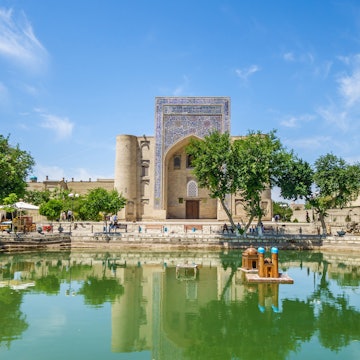
How to get your cell phone connected in Taiwan: eSIMs, wi-fi and mobile networks

Mar 31, 2025 • 8 min read

National Chiang Kai-shek Memorial Hall in Taipei. Alamy Stock Photo
Taiwan, the "beautiful isle", is a land of natural wonder, electric cities and layers of fascinating culture. One of Asia’s most progressive societies, it’s also one of its most tech-forward, a global leader in advanced chips and semiconductors that power everything from smartphones to satellites. Chances are, the device you're reading this on has a little bit of Taiwan inside.
And when it comes to connectivity, Taiwan is no slouch. Unlike mainland China across the strait, Taiwan doesn’t censor its internet behind a "Great Firewall" or block certain apps, meaning all the tools you might need for a great trip – Google Maps, Instagram, Uber, Google Translate and whatever else – are openly accessible. So here’s everything you need to know about getting connected in Taiwan, from local cell phone networks to the best eSIM providers.

Will my phone work in Taiwan?
Yes, modern smartphones should work without a hitch in Taiwan, but roaming with a US carrier can get expensive pretty quickly. The likes of Verizon, AT&T and T-Mobile charge eye-watering rates for Pay As You Go calls, messages and data in Taiwan. And be aware that data usage mounts up faster than you think. One gigabyte might last a couple of days if you’re just checking locations on Google Maps, looking things up online and sending messages and emails; but if you plan to stream movies and TV shows, or upload reams of photos and videos, it’ll be gone in a flash.
At the very least you’ll want to purchase an international roaming package, such as Verizon’s TravelPass, which for Taiwan costs US$12 per day plus tax. Do the math, though, and a few days in the country adds up to a hefty outlay. If your phone is unlocked, options like local SIM cards or international eSIMs, such as Saily or Airalo, can be a much smarter, cheaper investment.
What mobile networks are available in Taiwan?
Taiwan has three major mobile networks: Chunghwa Telecom, Taiwan Mobile and FarEasTone.
Chunghwa Telecom: the biggest and most established provider, which also has the widest coverage, extending to cover remote wilderness regions.
FarEasTone: considered the top player in terms of 5G coverage, especially in Taipei and other cities.
Taiwan Mobile: the second-largest network overall, strong in urban centers and with some of the fastest and most reliable 4G speeds across the country.
There’s nothing to choose between the three carriers when it comes to costs and packages for prepaid SIM cards for short-term visitors. All sell cards at both 4G and 5G speeds, and you can select coverage that offers unlimited data over three to 30 days. Prices start at NT$300 (US$9.02) for a three- or five-day prepaid 4G SIM with unlimited data, up to NT$1600 (US$48) for a 30-day card with 5G speed and unlimited data. These cards generally also include a small amount of local call credit, for making calls within Taiwan.

How can I get a local SIM card?
All three mobile networks have sales counters at Taoyuan International Airport (TPE), Taiwan’s main hub and the arrival point for most international flights. You’ll also find kiosks at Songshan (TSA) and Kaohsiung (KHH) airports. English-speaking staff can help you set up your SIM on the spot. You can also preorder a SIM online, using third-party service providers like KKday, and collect it at the airport.
It’s generally best to grab a SIM card at the airport, since the registration process requires your passport. You can do it later by popping into a store run by one of the three mobile carriers, but English language levels might vary, wait times could be longer, and you might also be required to provide two forms of ID (passport and driving license, for example), which could be a hassle. Convenience stores aren’t a good bet since they mostly sell prepaid SIMs for residents, which require local ID or an ARC (Alien Resident Certificate).
Once your new SIM is activated, check the data is working before you hightail it out of there and start your trip. Your phone number is usually on the back of your SIM card packaging – write it down or add it to your phone contacts list so you can share it with people you know.
Is eSIM available in Taiwan and how does it work?
A more straightforward solution, and one you can take care of before you fly, is getting an eSIM. Taiwan’s mobile networks don’t generally provide eSIMs for short-term visitors, but the country is fully compatible with international eSIM services.
eSIMs offer a few advantages to a physical SIM:
It can be bought anywhere, even before you leave home, so you have access as soon as you land.
There's no passport, fingerprint or address required.
You don't need to remove your current SIM.
You can use several carriers and phone numbers at once.
If you run out of data, it's easy to add more.
They're available on some smartphones, tablets and watches.
Getting an eSIM is a great time-saver since you can set it up before your trip and avoid hanging around in the airport arrivals fiddling with phones and SIM cards when you’ve just stepped off a flight. Another advantage is that your eSIM will be working as soon as you’ve landed, meaning you can get connected without delay, let loved ones know you’ve arrived safely, organize your onward journey, and move on from the airport hassle-free.
There is a range of eSIM providers out there, but Lonely Planet recommends Saily as our eSIM partner for Taiwan. As well as offering a wide variety of eSIM packages – starting at just US$3.79 for 1GB for seven days but going up to 20GB for 30 days – Saily’s eSIMs come with enhanced security features such as the ability to change your virtual location and block ads and tracking services. Use code LP5 to receive 5 percent off your Saily mobile data plan.

Where can I find reliable wi-fi in Taiwan?
There’s a number of places you can find wi-fi in Taiwan:
Taoyuan International Airport provides free wi-fi service in its public areas, meaning you can get online pretty much as soon as you transition from the airplane cabin to the arrivals terminal.
Trains and stations on Taiwan High Speed Rail (THSR) offer free wi-fi, and the same goes for Taoyuan Metro and the Taoyuan Airport MRT.
When you’re out and about, looks for free public wi-fi at coffee chains like Starbucks, convenience stores, and at major tourist attractions like the National Palace Museum in Taipei.
Hotels and guesthouses all typically offer free wi-fi for guests and visitors, and look out for iTaiwan free wi-fi hot spots, a government scheme with locations all over the country.
When using public wi-fi in Taiwan, take care if sending or receiving sensitive information such as when using online banking or entering passwords. If you need to send sensitive data, consider using your phone data instead, or connecting via a Virtual Private Network (VPN) to ensure you're 100% secure.
How fast and reliable is the internet?
Unsurprisingly for such a tech-loving nation, internet speeds and reliability are towards the top end of global standards. In the Speedtest Global Index, a ranking of internet speeds by country, Taiwan comes in at a very respectable 17th in the world for fixed broadband performance and 29th for mobile.
Are there any internet restrictions or censorship laws?
No, progressive Taiwan has a notably free and open online environment. Freedom House, a nonprofit that conducts research and advocacy on political freedom and human rights, reports that Taiwan “hosts one of the freest online environments in Asia” with an information landscape characterized by “affordable internet access, diverse content, and a lack of website blocks or internet shutdowns”.

Can I stay connected at major tourist sites?
Yes, major tourist attractions in Taipei, including the National Palace Museum and Chiang Kai-shek Memorial Hall, offer free public wi-fi. Off the beaten track in places like Taroko Gorge, head to the nearest tourist information office or visitor center to get connected.
Will I encounter language barriers when getting connected?
Levels of spoken English in Taiwan are generally good, especially among the young, and the three main network providers have 24-hour customer hotlines in English, so it’s unlikely you’ll run into any insurmountable language barriers, and you’ll be absolutely fine if purchasing and setting up a SIM in Taoyuan Airport.
How much does it cost to stay connected in Taiwan?
Taiwan’s three mobile networks have pretty much identical pricing on their products, and all offer unlimited data at either 4G (cheaper) or 5G, with the price varying depending on the number of days: either three, five, seven, 10, 15 or 30 days. The cheapest option is three days of 4G for NT$300 (US$9.02), while seven days of 5G costs NT$800 (US$24), and 15 days comes in at NT$1200 (US$36).
International eSIM providers, including Saily, tend to charge for units of data rather than offer unlimited use. For light users, or those on a longer trip, this can be economical: seven days with a 1GB limit costs just US$3.79, while 5GB over 30 days costs US$11.39.
Wi-fi passes aren’t really an option in Taiwan, but iTaiwan hosts free wi-fi hot spots at locations like tourist information centers, visitor centers, transport hubs and other public areas all over the country.

What local tech customs or etiquette should I be aware of?
Taiwanese phone etiquette is generally polite, though speakerphone use is fairly common, especially among older generations. On public transport, it's expected that passengers set their phones to silent mode. When it comes to messaging, LINE is by far the most popular app, used for everything from texting and voice calls to following official accounts for businesses and services.
Taiwan’s trains and long-distance buses are equipped with USB charging ports and power sockets. Taiwan uses a standard voltage of 110V at 60Hz, and the most common plug type is Type A (two flat parallel pins, like in the US), though you'll also find three-pronged Type B.
How do I contact emergency services if needed?
In an emergency, use the following numbers:
Police: 110
Fire and ambulance: 119
Operators may not always speak English, but Taiwan has a dedicated 24-hour tourist hotline (0800-011-765) with English-speaking staff who can assist in emergencies. If calling from a mobile, you may need to dial +886 800-011-765.













